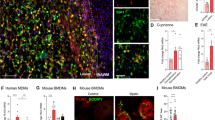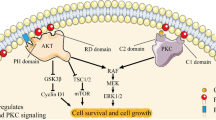Summary
Many ependymal cells of the infundibular recess and many glial cells of the external layer send their processes to the perivascular space of capillary loops of the portal plexus. The ultrastructure of these vascular processes is described. They may contain various inclusions: (1) large, osmiophilic globules (0,5–2 μ in diameter), mostly termed “lipid inclusions”; (2) irregularly formed, granular inclusions with an evenly distributed content (500–2000 Å in diameter); (3) circular granules comprising an electron-lucent centre surrounded by an annular wall of electron-dense particles (1200–1600 Å in diameter).
This type of granule seems to be characteristic for the vascular processes in the external layer of the Wistar rat. Frequently accumulations of these granules are found together with other inclusions in the widened end-feet of the vascular processes. The occurrence of exocytosis at the perivascular surface membrane of the vascular processes indicates a release of substances into the blood.
Neuro-glial synapses in the infundibulum are mainly found between nerve fibres of the tuberohypophyseal tract and the vascular end-feet of ependymal and glial cells. The synaptic cleft often contains filamentous or granular material. Together with tubular and vesicular membrane profiles such particles are also found in the postsynaptic area of the ependymal and glial processes. The functional significance of these contacts is discussed particularly with respect to the release of neuronal substances.
Zusammenfassung
Zahlreiche Ependymzellen des Recessus infundibularis und Gliazellen der Zona externa besitzen Fortsätze, die bis an den perivaskulären Raum der Kapillarschlingen des Portalplexus heranreichen. Die Ultrastruktur dieser Gefäßfortsätze wird beschrieben. Sie können verschiedenartige Einschlüsse enthalten: 1. große, runde osmiophile Einschlüsse (0,5–2 μ im Durchmesser), die als „lipid inclusions“ bezeichnet werden; 2. unregelmäßig geformte, granuläre Einschlüsse mit gleichmäßiger Elektronendichte (500 bis 2000 Å im Durchmesser); 3. rundliche Granula mit einem hellen Zentrum und ringartig um dieses Zentrum gelagerten elektronendichten Körnchen (1200–1600 Å im Durchmesser).
Der letztgenannte Granulatyp scheint ein charakteristisches Merkmal der Gefäßfortsätze in der Zona externa der Wistar-Ratte zu sein. Meist häufen sich die Körnchen gemeinsam mit den anderen beschriebenen Einschlüssen in den kolbenförmigen Endigungen der Gefäßfortsätze. Exocytosevorgänge an der dem perivaskulären Raum zugewandten Oberflächenmembran der Fortsätze weisen auf eine Abgabe von Substanzen an die Blutbahn hin.
Neurogliöse Synapsen finden sich im Infundibulum vorwiegend zwischen Nervenfasern des Tractus tuberohypophyseus und Gefäßfortsätzen der Ependym- und Gliazellen. Der synaptische Spalt enthält häufig fädige oder körnige Strukturen. Solche Partikel finden sich zusammen mit tubulären oder vesikulären Membranprofilen auch im synapsennahen Bereich des Glia- oder Ependymfortsatzes. Die funktionelle Bedeutung dieser Synapsen insbesondere für die Abgabe neuronaler Substanzen wird diskutiert.
Similar content being viewed by others
Literatur
Christ, J. F.: Nerve supply, blood supply and cytology of the neurohypophysis. In: The pituitary gland (eds. G. W. Harris and B. T. Donovan), vol. 3, p. 62–130. Oxford: Butterworths 1966.
Diepen, R.: Hypothalamus. In: Handbuch der mikroskopischen Anatomie des Menschen, Bd. 4/VII. Berlin-Göttingen-Heidelberg: Springer 1962.
Gersh, J.: The structure and function of parenchymatous glandular cells in the neurohypophysis of the rat. Amer. J. Anat. 64, 407–443 (1939).
Giesing, M.: Biochemie der neurosekretorischen Elementargranula und der lipidreichen Grana der Neurohypophyse von Ratten. Diss. Med. Fakultät Bonn 1971.
Knowles, F., Vollrath, L.: Synaptic contacts between neurosecretory fibres and pituicytes in the pituitary of the eel. Nature (Lond.) 206, 1168–1169 (1965).
Knowles, F., Vollrath, L.: A functional relationship between neurosecretory fibres and pituicytes in the eel. Nature (Lond.) 208, 1343 (1966).
Krisch, B., Becker, K., Bargmann, W.: Exocytose im Hinterlappen der Hypophyse. Z. Zellforsch. 123, 47–54 (1972).
Krsulovic, J., Brückner, G.: Morphological characteristics of pituicytes in different functional stages. Light- and electronmicroscopy of the neurohypophysis of the albino rat. Z. Zellforsch. 99, 210–220 (1969).
Krsulovic, J., Ermisch, A., Sterba, G.: Electron microscopic and autoradiographic study on the neurosecretory system of albino rats with special consideration of the pituicyte problem. In: Bargmann and Scharrer: Aspects of neuroendocrinology, p. 166–172, Berlin-Heidelberg-New York: Springer 1970.
Löfgren, F.: New aspects of the hypothalamic control of the adenohypophysis. Acta morph. neerl.-scand. 2, 220–229 (1959).
Monroe, B. G., Newman, B. L., Schapiro, S.: Ultrastructure of the median eminence of neonatal and adult rats. In: Brain endocrine interaction. Median eminence: Structure and Function, Int. Symp. Munich 1971, 7–26. Basel: Karger 1972.
Nagasawa, J., Douglas, W. W., Schulz, R. A.: Ultrastructural evidence of secretion by exocytosis and of “synaptic vesicle” formation in posterior pituitary glands. Nature (Lond.) 227, 407–409 (1970).
Nakai, Y.: Electron microscopic observations on synapse-like contacts between pituicytes and different types of nerve fibres in the anuran pars nervosa. Z. Zellforsch. 110, 27–39 (1970).
Ortmann, R.: Über experimentelle Veränderungen der Morphologie des Hypophysen-Zwischenhirnsystems und die Beziehung der sog. „Gomorisubstanz“ zum Adiuretin. Z. Zellforsch. 36, 92–140 (1951).
Raviola, E., Raviola, G.: Histochemistry of the rat neurohypophysial pituicyte lipid granules. Autooxidation of unsaturated fats during fixation. J. Histochem. Cytochem. 11, 176–187 (1963).
Rodríguez, E. M.: Ultrastructure of the neurohaemal region of the toad median eminence. Z. Zellforsch. 93, 182–212 (1969).
Rodríguez, E. M., La Pointe, L.: Histology and ultrastructure of the neural lobe of the lizard, Klauberina riversiana. Z. Zellforsch. 95, 37–57 (1969).
Romeis, B.: Die Hypophyse. In: Handbuch der mikroskopischen Anatomie des Menschen, Bd. VI/3. Berlin: Springer 1940.
Schachenmayr, W.: Über die Entwicklung von Ependym und Plexus chorioideus der Ratte. Z. Zellforsch. 77, 25–63 (1967).
Scott, D. E., Krobisch Dudley, G., Gibbs, F. P., Brown, G. M.: The mammalian median eminence. A comparative and experimental model. In: Brain-Endocrine Interaction. Median Eminence: Structure and Function, Int. Symp. Munich 1971, p. 35–49. Basel: Karger 1972.
Smoller, C. G.: Ultrastructural studies on the developing neurohypophysis of the pacific treefrog, Hyla regilla. Gen. comp. Endocr. 7, 44–73 (1966).
Sterba, G., Brückner, G.: Zur Funktion der ependymalen Glia in der Neurohypophyse. Z. Zellforsch. 81, 457–473 (1967).
Wittkowski, W.: Synaptische Strukturen und Elementargranula in der Neurohypophyse des Meerschweinchens. Z. Zellforsch. 82, 434–458 (1967a).
Wittkowski, W.: Zur Ultrastruktur der ependymalen Tanycyten und Pituicyten sowie ihre synaptische Verknüpfung in der Neurohypophyse des Meerschweinchens. Acta anat. (Basel) 67, 338–360 (1967b).
Wittkowski, W.: Zur funktionellen Morphologie ependymaler und extrapendymaler Glia im Rahmen der Neurosekretion. Elektronenmikroskopische Untersuchungen an der Neurohypophyse der Ratte. Z. Zellforsch. 86, 111–128 (1968).
Wittkowski, W.: Ependymokrinie und Rezeptoren in der Wand des Recessus infundibularis der Maus und ihre Beziehung zum kleinzelligen Hypothalamus. Z. Zellforsch. 93, 530–546 (1969).
Wittkowski, W.: Nervenfasern mit ultrastrukturell verschiedenen Elementargranula im Hypophysenhinterlappen des Rhesusaffen. Z. Zellforsch. 107, 499–507 (1970).
Wittkowski, W.: Synapses and membrane junctions between neurosecretory neurons and pituicytes in the neurohypophysis of the rhesus monkey. J. Anat. (Lond.) 109, 342 (1971).
Zambrano, D., De Robertis, E.: Ultrastructural changes of the neurohypophysis of the rat after castration. Z. Zellforsch. 86, 14–25 (1968).
Author information
Authors and Affiliations
Additional information
Mit dankenswerter Unterstützung durch den Herrn Bundesminister für Bildung und Wissenschaft.
Rights and permissions
About this article
Cite this article
Wittkowski, W. Zur Ultrastruktur der Gefäßfortsätze von Ependymund Gliazellen im Infundibulum der Ratte. Z.Zellforsch 130, 58–69 (1972). https://doi.org/10.1007/BF00306994
Received:
Issue Date:
DOI: https://doi.org/10.1007/BF00306994




